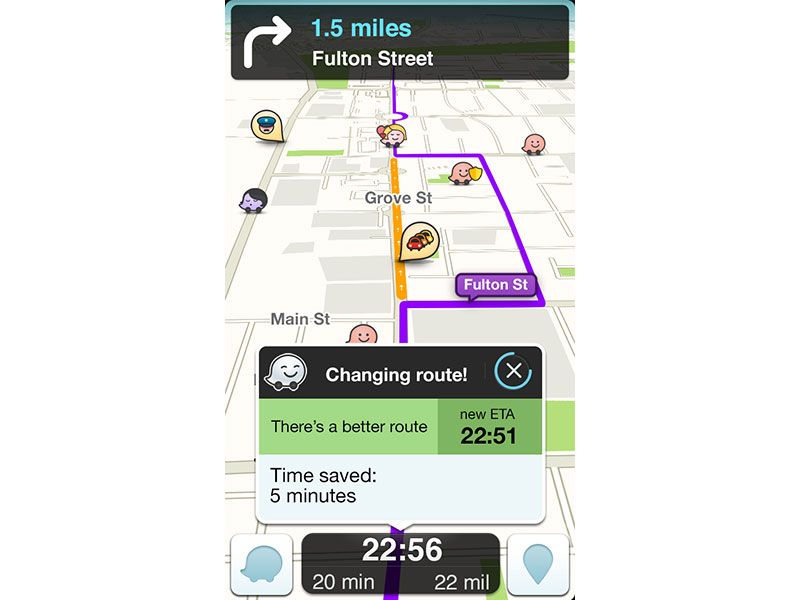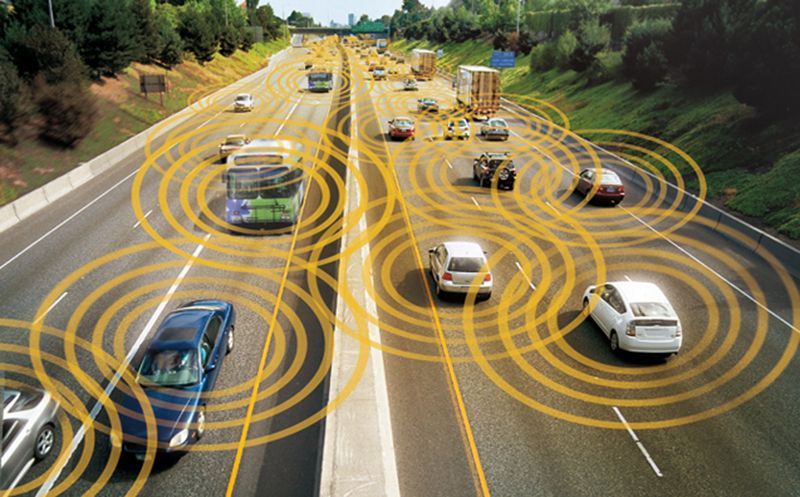Will We Ever Be Able to Make Traffic Disappear?
City engineers make changes in the timing of signals to keep cars moving, but cell phone data and vehicle-to-vehicle communication could ease the task
/https://tf-cmsv2-smithsonianmag-media.s3.amazonaws.com/filer/ad/24/ad24d9fb-439a-40eb-8695-04816285c48d/can_traffic_be_a_way_to_make_environmental_improvements.jpg)
Every time a car drives through a major intersection, it becomes a data point. Magnetic coils of wire lay just beneath the pavement, registering each passing car. This starts a cascade of information: Computers tally the number and speed of cars, shoot the data through underground cables to a command center and finally translate it into the colors red, yellow and green. On the seventh floor of Boston City Hall, the three colors splash like paint across a wall-sized map.
To drivers, the color red means stop, but on the map it tells traffic engineers to leap into action. Traffic control centers like this one—a room cluttered with computer terminals and live video feeds of urban intersections—represent the brain of a traffic system. The city's network of sensors, cables and signals are the nerves connected to the rest of the body. “Most people don't think there are eyes and ears keeping track of all this stuff,” says John DeBenedictis, the center's engineering director. But in reality, engineers literally watch our every move, making subtle changes that relieve and redirect traffic.
The tactics and aims of traffic management are modest but powerful. Most intersections rely on a combination of pre-set timing and computer adaptation. For example, where a busy main road intersects with a quiet residential street, the traffic signal might give 70 percent of “green time” to the main road, and 30 percent to the residential road. (Green lights last between a few seconds and a couple minutes, and tend to shorten at rush hour to help the traffic move continuously.) But when traffic overwhelms the pre-set timing, engineers override the system and make changes.
Almost all of the city's intersections are tracked by cameras, which allow engineers to visually confirm the source of problems. If a vehicle is stopped in an intersection, the control center might dispatch a police car or tow truck. If rush hour traffic clogs a road, engineers can change the timing of green lights to favor the busiest routes. Surprisingly, the goal is consistency, not velocity. “We're not really trying to speed traffic,” says DeBenedictis. “We're trying to make it move more efficiently, with fewer stops.”

Still, emerging sources of data could drastically improve our drives. For all the time and money spent on specialized sensors, Boston's engineers also track traffic using a free public app called Waze, which uses cell phone data to calculate travel times. Waze, which is now owned by Google, also shares data with cities like Barcelona and Tel Aviv. The car-sharing service Uber, meanwhile, offers cities data from its drivers—a suggestion that private sector innovations can play a crucial role in public services. These sorts of innovations are arguably much more efficient and cost-effective than embedding coils of wire into asphalt. Instead of building special technology, they harness existing data to reveal problems. Future generations of programs like Waze, meanwhile, might try to predict traffic far in advance.
Simply owning a cell phone now generates useful data for traffic researchers. MIT associate professor Marta Gonzalez recently analyzed hundreds of thousands of cell phone location records to figure out which roadways were clogging up. Her data suggested that only 2 percent of roads reached capacity during rush hour—and small improvements in just two neighborhoods could reduce Boston area travel times by 18 percent. In other words, we don't need to redesign our cities to maintain our love affair with automobiles. Our traffic systems just need better brains.

Many of the central problems of traffic are well understood, but remain unsolved. For example, traffic control centers expend a huge amount of effort trying to make rush hour slightly more efficient—but the very idea of rush hour is inefficient. “When we design roads, we're really trying to design it for two small parts of the day,” says Brian Wolshon, a traffic engineering professor at Louisiana State University. Traffic jams are just the spikes in usage that occur when everybody tries to get to work at the same time. Add to that the fact that, as Wolshon explains, “automobiles are really only in use a very small percentage of the time”—at most a few hours per day. This means that most roads—and most cars—are empty most of the time.
Wolshon points to a central irony of our driving patterns: “The faster we go, the more we tend to spread out.” In an ideal world, traffic would become denser and faster during peak hours, in roughly the way that rivers speed up when riverbanks narrow. Individual drivers can't safely manage this, but data could make it possible. In the not too distant future, cars could use sensors and communication technology to maintain fixed distances from neighboring vehicles; these systems could warn drivers if an accident seems imminent or perhaps even engage the car’s brakes for the driver. (This is a simplified version of self-driving cars, which face the major roadblocks of reliability and legality.) In fact, federal agencies including the Department of Transportation plan to make “vehicle-to-vehicle communication” technology mandatory within just a few years.

“The ideal solution, as crazy as this sounds, would be to have vehicles almost like in NASCAR—where we're literally driving bumper to bumper at 70 miles an hour,” says Wolshon. Mathematically speaking, that scenario could increase traffic flows by an incredible seven times. In that sort of future, Wolshon says, driver decisions will become unimportant, and “the traffic stream will act like a train of connected vehicles.”
In the traffic world, time is the coin of the realm. Engineers describe signal overrides as “moving time around”; every tiny change represents a few seconds saved or lost. The most valuable projects are those that take hardly any time to implement, while saving commuters as much time as possible. The city recently spent $4,000 re-timing intersections in Boston's Back Bay neighborhood—but DeBenedictis says that the money was less important than the man-hours. “It's time,” he says. “The engineer, the brainpower you're using to make those decisions.” In this case, the few days it took to collect and interpret data were well spent: Travel times in the area dropped by 29 percent.
Of course, drivers hardly notice typical traffic improvements. “If we can gain, say, 4 percent efficiency, that's 45 seconds or so,” says Wolshon. Commuters hate gridlock, but the converse is not necessarily true. They pay little attention to quick and easy commutes. In other words, invisibility can be a sign of success: A well-run traffic system is one that commuters ignore. “When things are working well, you don't get many calls,” says DeBenedictis. “We know that's a good thing.”
Real innovations in traffic are notoriously elusive. Wolshon and his colleagues have a favorite pessimistic quote: “Traffic engineers don't solve problems. They move them to different locations.” Fix one traffic jam and another might appear across town. Improvements in traffic can actually encourage people to drive more. The root problem is that traffic is never local: through thousands of distinct driver decisions, it moves and morphs. Drivers try to adapt to traffic—which creates new traffic that drivers then have to adapt to. On highways, a single car that slams on the brakes can cause an accordion deceleration three miles long.
Maybe there's a small comfort in that problem, though. Traffic jams are a reminder of the rippling connections between us. We all have to share the same skinny strip of pavement, and everyone stands to benefit if we learn to use it more intelligently. Traffic is teamwork.